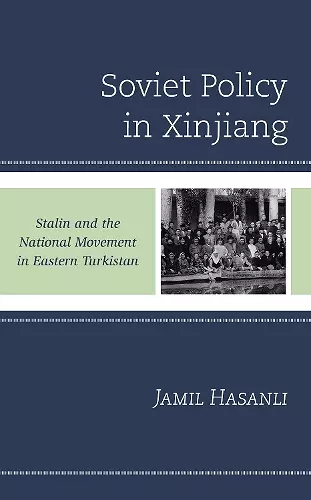Soviet Policy in Xinjiang
Stalin and the National Movement in Eastern Turkistan
Format:Paperback
Publisher:Bloomsbury Publishing PLC
Published:11th May '22
Currently unavailable, and unfortunately no date known when it will be back
This paperback is available in another edition too:
- Hardback£95.00(9781793641267)

Using recently declassified Soviet documents, Jamil Hasanli examines Soviet involvement in the anti-China rebellion in East Turkistan. Hasanli takes readers back to the early 1930s when the Turkic national movement was suppressed by the Soviet government and the USSR. Hasanli deftly illustrates how Stalin’s policies toward the movement changed after the turning point of World War II and the treachery of Sheng Shicai, leading up to the 1944 establishment of the Eastern Turkistan Republic and the start of the Cold War.
Between 1931 and 1949, the USSR intervened in the politics of Xinjiang, China’s northwest territory, first supporting an independent-minded Chinese strongman, then the Chinese Nationalist government, and later anti-Chinese Muslim forces.... Hasanli draws on Russian and American archives to illuminate the twists and turns of Soviet policy, arguing that Stalin was guided above all by his determination to secure the USSR’s long southern border. In this, Xinjiang policy resembled Stalin’s approach to Iranian Azerbaijan and Turkey in reference to Armenia, topics of Hasanli’s previous books. He makes effective use of recent studies of Xinjiang history by scholars with East Asian expertise, including scholars writing in Russian, so the perspectives of Chinese, Uyghur, Kazakh, and Mongol political actors are represented. Recommended. * Choice Reviews *
Moscow’s role in Xinjiang during the two decades from 1930 to 1950 is a source of controversy and debate among historians of the region, but remains poorly known outside that field. Drawing on important findings in the Russian archives, Jamil Hasanli’s book sheds new light on this major Soviet foreign intervention and clarifies Moscow’s policies towards the province’s rulers and rebels. This book will be an essential reference point for all future work on the history of Republican Xinjiang and oppositional politics among its Turkic-speaking peoples, and on the Sino-Soviet relationship in Central Asia more broadly. -- David Brophy, University of Sydney
Jamil Hasanli is one of the most original historians of the Cold War. This book—the latest in a series of path-breaking studies—shows how Joseph Stalin manipulated an ethnic insurgency in Xinjiang to reach his geopolitical goals in Northwest China. This is an essential, eye-opening read for understanding Stalin’s foreign policy. -- Sergey Radchenko, Cardiff University
The depth of Soviet involvement in Xinjiang during the first half of the twentieth century has long been contested and debated by scholars, particularly regarding the Soviet Union’s role in creating and supporting the East Turkestan Republic (1944-1949). Finally, with this book, Jamil Hasanli offers the definitive study of the Soviet Union and Xinjiang. Based on remarkable evidence collected for the first time from former Soviet archives, Hasanli shows how and why Soviet leader Joseph Stalin sought to manipulate developments in Xinjiang to the benefit of the USSR. -- Charles Kraus, Woodrow Wilson International Center for Scholars
Soviet Policy in Xinjiang is another significant contribution to the study of the history of Republican Xinjiang and will be extremely useful for understanding this period. * Central Asian Survey *
Soviet Policy in Xinjiang is a valuable historical resource for the Soviet viewpoint, including Moscow’s secret decisions, correspondence and strategic policies. The book is recommended for those interested in Soviet historiographical accounts of Xinjiang and Eastern Turkistan, Central Asia and Asian studies, national movement studies and Stalinist history. * Europe-Asia Studies *
No serious scholar of Xinjiang can afford to ignore this book. On every page the reader will encounter fascinating new statistics and commentary drawn from the Soviet archives, some of which is truly jaw-dropping. * Journal of Cold War Studies *
ISBN: 9781793641281
Dimensions: 230mm x 154mm x 22mm
Weight: 445g
294 pages